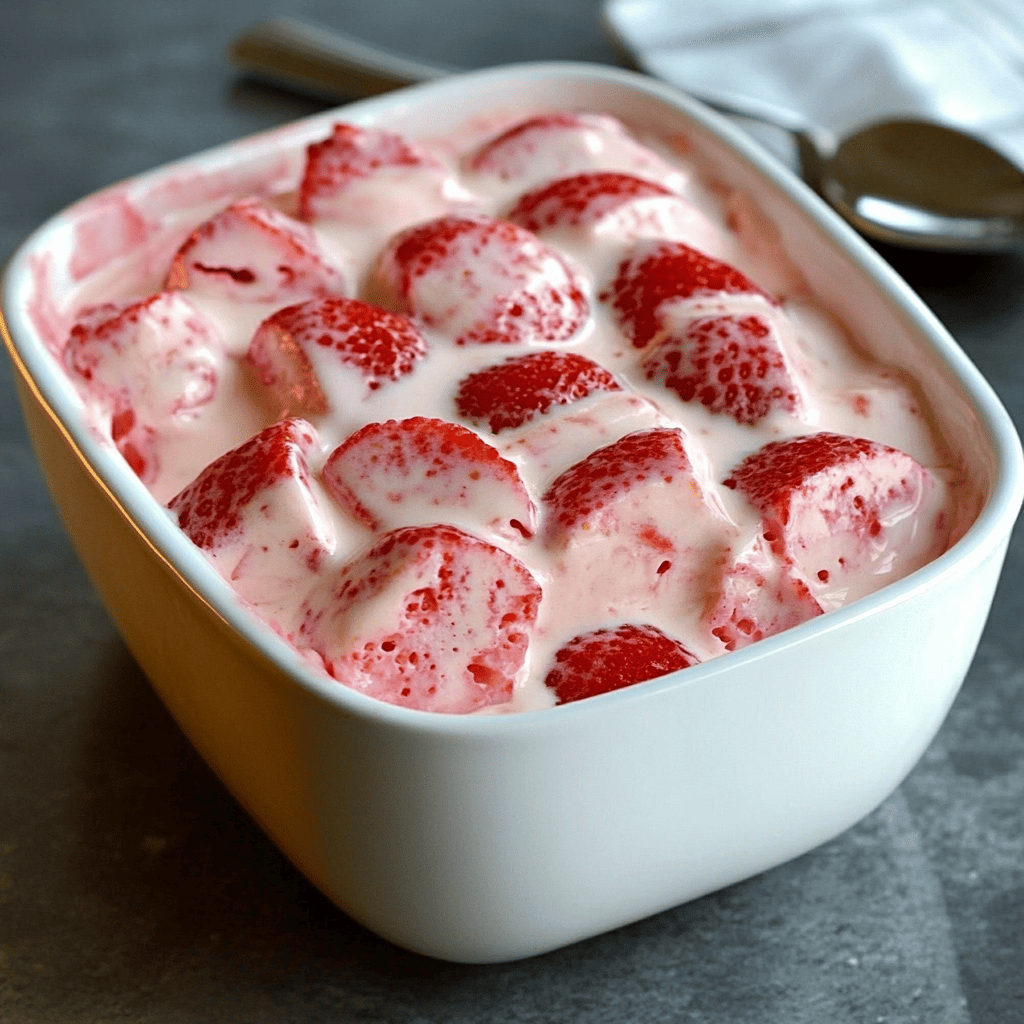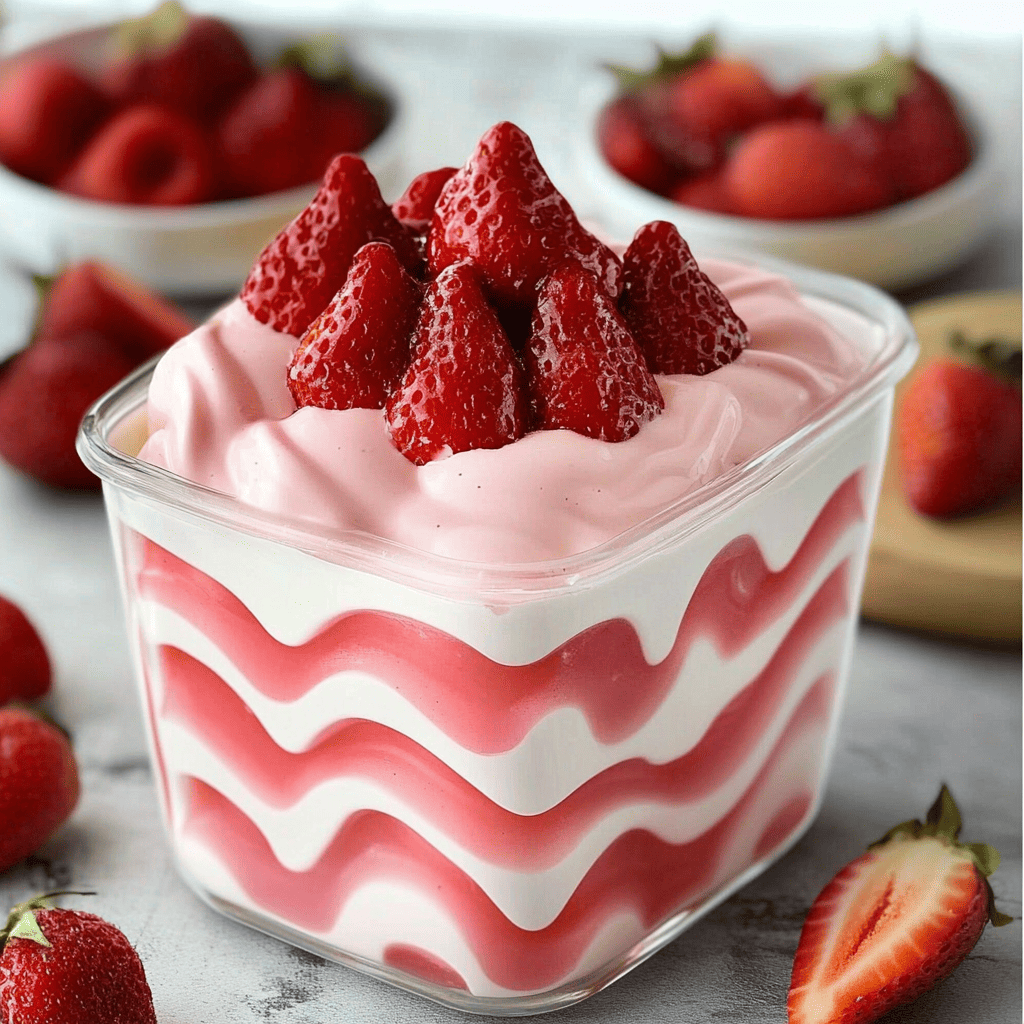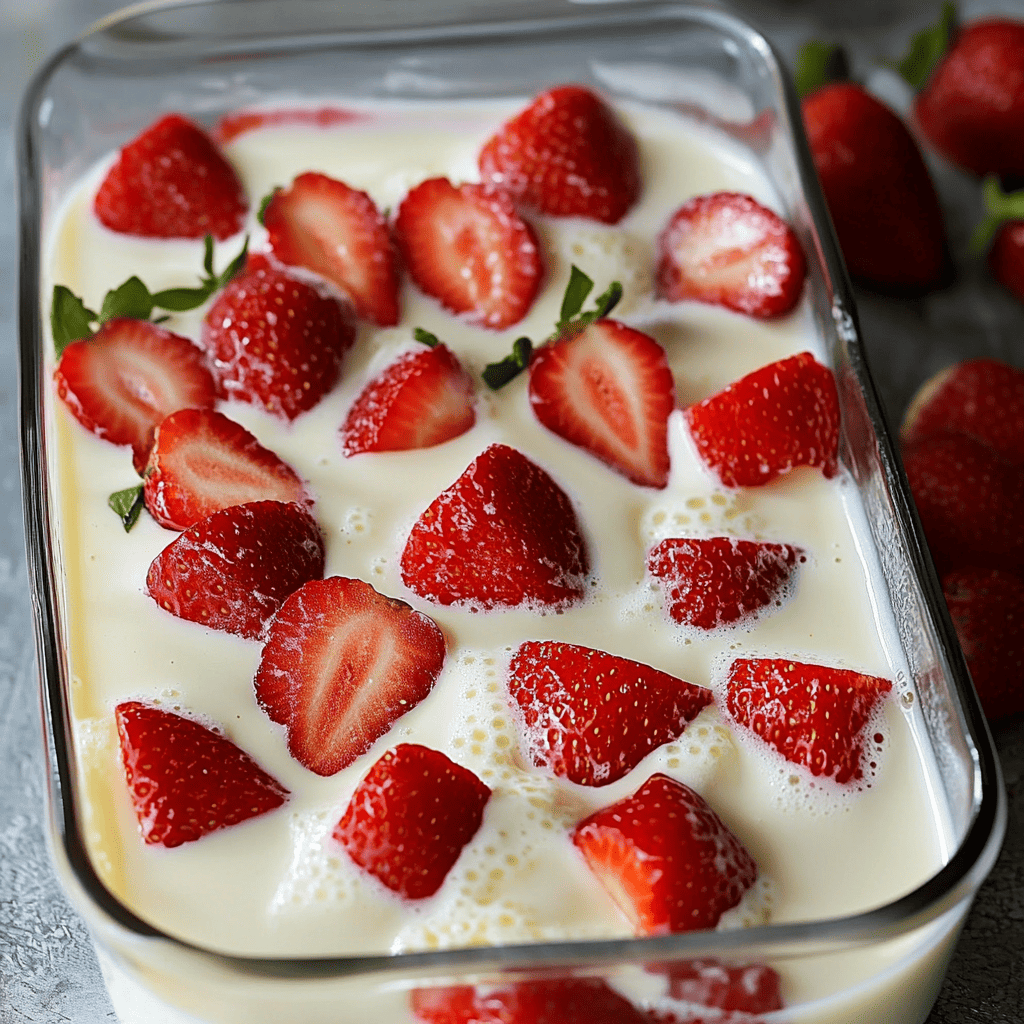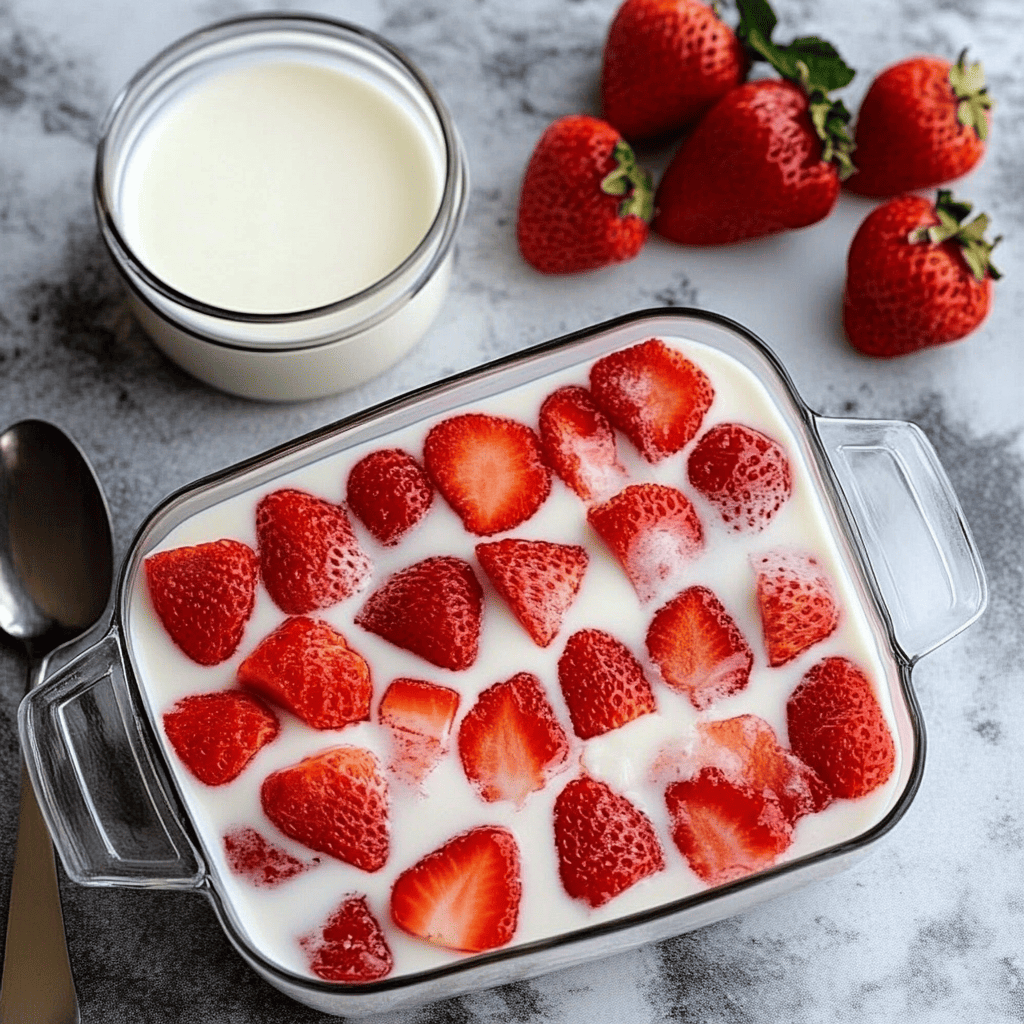Strawberry and Cream Jelly
Introduction
Strawberry and cream gelatin is a classic dessert that combines the freshness of strawberries with a creamy, sweet mixture, achieving a perfect balance of flavor and texture. This dessert is popular in Latin America, especially in Mexico, where gelatin is an essential part of traditional baking. Its preparation is simple and requires few ingredients, making it an ideal choice for any occasion.
History and Origin
Gelatin is a dessert that has its roots in European cuisine, where more elaborate versions were prepared using animal collagen. Over time, this technique was simplified and popularized in America, becoming an affordable and versatile option.
In Mexico and other Latin American countries, gelatin is a very common dessert, served at family gatherings, parties, and celebrations. The strawberries and cream variant was born as a fusion of classic milk gelatin and the traditional strawberries and cream dessert, creating an irresistible combination.
History of Strawberry and Cream Jelly
Strawberry and cream gelatin is a traditional dessert that combines the freshness of fruit with the smoothness of a sweet dairy mixture. Its origins are linked both to the evolution of gelatin and to the use of strawberries in baking.
The Origin of Gelatin
The concept of gelatin has a long history dating back to ancient times:
- In the 15th century , it was discovered that broths obtained by boiling animal cartilage and bones could solidify when cooled, giving rise to the first gelatinous desserts.
- In the 19th century , with advances in the food industry, it was possible to isolate gelatin in powder form, making it easier to use in cooking.
- Commercial gelatin became popular in the 20th century thanks to its easy preparation and versatility to include fruits, milk, and various flavors.
Strawberries in Baking
Strawberries have been appreciated since ancient times, but their use in desserts was consolidated in Europe during the Renaissance:
- In the 14th century , the French began using strawberries in sweet creams and sauces.
- In the 18th century , with the arrival of refined sugar and more affordable dairy products, desserts such as strawberries and cream, mousses and fruit jellies emerged.
- In Latin America , the combination of gelatin with strawberries and cream became popular in the mid-20th century at family gatherings and children’s parties.
Expansion and Popularity
Strawberry and cream jelly became a highly appreciated dessert in countries such as Mexico, Colombia, Venezuela and Peru , due to:
Its easy preparation and low cost.
The combination of mild, fresh flavors.
Its colorful presentation makes it attractive for parties.
Today, this dessert remains a classic choice for celebrations and has evolved with new variations, such as sugar-free versions, with other fruits, or with vegan ingredients.

Ingredients
For the creamy mixture:
- 1 can of condensed milk (397 g)
→ Provides sweetness and a dense, creamy texture. - 1 can of evaporated milk (approx. 360 ml)
→ Provides a light, creamy, unsweetened dairy base. - 1 cup half and half (or light whipping cream)
→ Softens the mixture and improves the texture. - ½ cup sour cream (optional)
→ Adds a slight acidic touch that balances the sweetness. - 1 cup of cold water
→ Necessary to hydrate the gelatin. - 4 tablespoons of gelatin (approximately 28 g)
→ It is the gelling agent that allows the gelatin to set.
For the fruity touch:
- 2 cups fresh strawberries, washed and halved or sliced
→ They add color, natural texture, and freshness to the gelatin.
Step-by-step preparation
Hydrate the gelatin
- In a small container, dissolve the 4 tablespoons of gelatin in 1 cup of cold water .
- Let it sit for 5 to 10 minutes until it puffs up.
- Then, melt the gelatin in the microwave (20 seconds) or in a double boiler until it is completely liquid (do not boil).
Mix the dairy ingredients
- In the blender, add the condensed milk, evaporated milk, half and half cream, and sour cream .
- Blend until smooth and even.
Add the gelatin
- Once the mixture is smooth, add the melted gelatin little by little and continue blending to avoid lumps.
- The mixture should be liquid, creamy and uniform.
Whip the gelatin
- In a large mold or individual molds, place the strawberries on the bottom .
- Carefully pour the creamy mixture over the strawberries.
- Gently tap the mold against the table to remove bubbles.
Refrigerate
- Refrigerate for at least 4 hours or until completely set .
Unmold and serve
- To unmold more easily, submerge the mold for a few seconds in warm water (without letting any water get into the gelatin).
- Serve very cold and enjoy.
Tips and Variations
For a more intense flavor , you can add vanilla extract or a little strawberry liqueur.
If you prefer a lighter texture , you can reduce the amount of sour cream and half and half.
For a more attractive presentation , sliced strawberries can be placed in the bottom of the mold before pouring the mixture.
Other fruits, such as peaches, blackberries, or mango, can be used for a different version.

Reflection Questions
What is the origin of gelatin, and how has it evolved in Latin American cuisine?
Why is gelatin an essential ingredient in preparing gelatin?
How does combining different types of dairy products influence the dessert’s texture and flavor?
How can the ingredients be adapted to make a healthier version?
How could the recipe be innovated without losing its traditional essence?
Additional Information about Strawberry Cream Jelly
Nutritional Benefits
Although it is a sweet dessert, strawberry and cream gelatin has some benefits:
Source of calcium : Thanks to evaporated milk, half and half, and condensed milk, it provides calcium to strengthen bones.
Natural protein : Gelatin is rich in collagen, which benefits skin, hair, and nails.
Vitamins and antioxidants : Strawberries contain vitamin C, an antioxidant that strengthens the immune system.
However, due to its high sugar and fat content, it is recommended to consume it in moderation or make lighter versions using unsweetened milk or alternative sweeteners.
Adaptations and Variations of the Recipe
Strawberry and cream jelly can be adapted according to your preferences and dietary needs:
Light version : You can use light or sugar-free products, such as unsweetened condensed milk and low-fat cream.
Vegan option : You can substitute the gelatin with agar-agar and the milks with plant-based alternatives such as almond or coconut milk.
Chocolate gelatin with strawberries : You can add cocoa powder to the mixture for a chocolatey touch.
With other fruits : In addition to strawberries, you can use mango, peaches, or blackberries for different flavor combinations.
Cultural Importance in Latin America
In many Latin American countries, gelatin is a traditional dessert found in celebrations such as:
Birthday parties – It’s common to see gelatin on tables alongside cake.
Baptisms and family reunions – It’s prepared as a fresh, easy-to-serve dessert.
Posadas and Christmas – Fruity and festively colored versions are included.
Its ease of preparation and the possibility of making individual portions make it ideal for sharing at any event.
Tricks for Perfect Gelatin
Avoid lumps : The gelatin should be incorporated slowly while beating the mixture.
Firmer texture : The amount of gelatin can be increased for a firmer consistency.
Creamier texture : A little natural yogurt or cream cheese can be added for a softer texture.
Easy unmolding : Running the mold under hot water for a few seconds helps the gelatin to come loose without breaking.
Did you know that…?
The first gelatins were made in the Middle Ages and were considered an exclusive dessert for the nobility.
Mexico is one of the countries where gelatin is most consumed , and it’s common to find it in different colors and flavors in stores and markets.
In some versions of this recipe, pieces of cookie or meringue are added to give the dessert more texture.
Questions about Strawberry and Cream Gelatin
- What is the origin of gelatin and how has it evolved throughout history?
- Why is strawberry and cream gelatin such a popular dessert in Latin America?
- What nutritional properties do strawberries and dairy products provide in this recipe?
- How can the recipe be modified to make a healthier or vegan version?
- What are the most common mistakes when making gelatin with cream and how to avoid them?
- What other ingredients could combine well with strawberry and cream gelatin to innovate its presentation?
- At what types of celebrations or events is this dessert most commonly served?
- What is the difference between using natural gelatin and commercial flavored gelatin in this preparation?
- How does texture influence the flavor perception of strawberry and cream gelatin?
- What techniques can be used to unmold gelatin without it breaking or losing its shape?
Texture and Flavor
- Texture:
Creamy, smooth, and slightly firm thanks to the gelatin. Fresh strawberries add a juicy, contrasting touch. - Flavor:
Sweet and balanced. The blend of milks offers a smooth and comforting dairy profile, while sour cream and fresh strawberries add a fruity, tangy touch that breaks up the sweetness.
Consumer Context
- Very common in Mexican celebrations such as birthdays, baptisms, or family reunions.
- It is also an ideal dessert for hot days , as it is served cold and is refreshing.
- It is often offered at parties as an alternative to cake or as part of dessert tables.
Visual Aspect
- Pale pink tones or white with strawberry red veins.
- It is presented in decorative molds or in individual portions.
- You can include whole or sliced strawberries inside and on top.
Curiosities
- It is a modern adaptation of the traditional “gelatin mosaic,” very popular in Latin America.
- Its creamy texture differentiates it from common water jellies.
- The combination of three types of milk is reminiscent of tres leches cakes, another Latin classic.
Estimated Nutritional Value (150g serving)
- Calories: 180–230 kcal
- Fat: 10–13 g
- Carbohydrates: 20–25 g
- Protein: 4–6 g
- Sugars: 18–22 g
(Values vary depending on proportions and brands used)
Additional Benefits and Interesting Facts
- Good source of calcium and protein due to the dairy base.
- Strawberries provide vitamin C and antioxidants .
- Gelatin can benefit the health of joints, skin and nails .
- You can substitute ingredients with light versions (low-fat condensed milk or half and half) to reduce calories.
- It can be prepared with various fruits , although strawberries are the most popular.
Other Information in Spanish
- It can be made in individual molds for elegant presentations.
- If a firmer finish is desired, the amount of gelatin can be slightly increased.
- It is important to hydrate the gelatin well in cold water before heating it to ensure a uniform texture.

Conclusion
Strawberry and cream gelatin is a dessert that represents the fusion of tradition and simplicity. Its origin dates back to the evolution of gelatin as a dessert in Latin American cuisine, where it has been adapted with local ingredients and regional preferences.
It’s easy to prepare, making it an excellent choice for celebrations or simply enjoying at home. Its versatility also allows each person to customize it to their tastes, whether by varying the fruits, dairy products, or even adding additional flavors.
This dessert stands out not only for its delicious flavor but also for its cultural value, as it has been part of the memories of many generations. Its smooth texture, balanced sweetness and acidity, and refreshing fruity note make it irresistible.
Strawberry and cream gelatin is a dessert that combines tradition, simplicity, and flavor in a single dish. Throughout history, gelatin has evolved from a dish exclusively for the nobility to an accessible and versatile food enjoyed around the world. Its combination with strawberries and dairy products gives it a creamy texture and a perfect balance between sweetness and freshness.
This dessert is an ideal choice for family gatherings and celebrations, as it’s easy to prepare, affordable, and visually appealing. It also allows for multiple variations, from low-sugar versions to vegan options using coconut milk and agar-agar instead of gelatin.
The success of this recipe lies in the quality of the ingredients and in properly following the steps for hydrating and mixing the gelatin to achieve a smooth, lump-free texture. Plus, its presentation can be customized by adding additional fruit or decorations to make it even more special.
In conclusion, strawberry and cream gelatin is not only a delicious dessert, but also a testament to how cuisine evolves while maintaining the essence of traditional flavors. Its easy adaptation to different tastes and dietary needs ensures that it remains a popular choice in sweet cuisine. Definitely a classic that never goes out of style!

